- Home
- Mark Chadbourn
Darkest hour aom-2
Darkest hour aom-2 Read online
Darkest hour
( Age of Misrule - 2 )
Mark Chadbourn
Mark Chadbourn
Darkest hour
The wind blows harshly through the cloisters; to my fancy, it brings with it the distant cries of anguish and despair that echo now around our land. These are indeed dark times. Here, beneath the magnificent vaulted roof of Salisbury Cathedral, a few of us struggle to keep the candle of humanity's faith alight; the last outpost of Christianity in a world grown Godless through too many gods. Sometimes even my own faith grows dim, though I joined the church more than thirty years ago. The old certainties have been blown away by that cold wind. Simply to believe in the one, pure thing in a time of everyday wonders and miracles is almost too much. For why should anyone believe in one thing when it is possible to believe in everything? But I struggle and I strive, and I continue the ministry that I have held all my adult life. Now, more than ever, I have a purpose. The Lord, perhaps, will grant me the strength to see Him clearly once more and permit me to spread His word across the land as my antecedents did in the first Dark Age.
It seems that in my blackest moments I draw most comfort not from contemplation of the divine, but through an examination of humanity. And in those times I like to turn my thoughts to the five who set out to be the saviours of our race, not through any desire for glory, but simply to serve the greater good; in their example we see humanity in its most glorious essence, forged through hardship and conflict.
The first of the five was Jack Churchill, an archaeologist, known to his friends as Church. A good man in many ways, but one damaged by life. For two years he had struggled with the blackest of emotions that accompanied the suicide of his girlfriend Marianne: grief, certainly, but mainly guilt that he had somehow been complicit in his inability to recognize whatever internal turmoil she had been experiencing that had driven her to such a terrible act. The second of the five was Ruth Gallagher, a lawyer, introspective and intelligent, given to controlling her emotions. She felt trapped in a career she found soulless, but which had been the wish of her father who had died of a heart attack soon after his brother had been murdered.
The two of them met one misty February morning just before dawn, underneath Albert Bridge on the banks of the Thames in London, where they witnessed an act of terrible ferocity: the murder of Maurice Gibbons, a Ministry of Defence civil servant, by a giant of a man whose face seemed to melt and change. Whatever it became was too awful for their minds to comprehend and they both fell unconscious.
Over the following days, the repressed memory of the sight assailed their subconscious, driving them to the edge of despair, forcing them to join forces to uncover the truth of what they had seen. And what they found when they probed into the hidden areas of their minds was at first too much to believe: it appeared that the figure had transformed into a monstrous, demonic being. Yet when they encountered Kraicow, an elderly, bedridden artist, their worst fears were confirmed, for Kraicow, too, had seen the creature.
During this period of personal upheaval, the world seemed to have been turned on its head. From all over the country came reports of bizarre supernatural acts, spontaneous miracles, wonders and terrors, discounted or jeered at by the cynical media. If only we all could have recognized those first signs then, we might have been able to prepare ourselves for what was to come. The culmination of this outbreak of the unknown, for Church at least, was the manifestation late one night of his dead girlfriend's spirit.
It was a turning point for this young man who was filled with so much darkness: a chance, possibly, to find the answer to all the questions that had tormented him. When he received a message over the Internet with a cryptic comment about "Marianne" from a woman purporting to have an insight into the strange events, he felt driven to investigate further. And so the external crisis and his own personal troubles converged.
A meeting was arranged with the woman, Laura DuSantiago, in the west of the land, and Ruth accompanied him. Yet they had barely passed beyond London's city limits when the dark forces moved against them. At a service station an attempt was made to kidnap Ruth by another face-changing creature much like the one they had seen that night they came together. With the help of a mysterious, elderly wanderer named Tom, Ruth was rescued, but by then it was impossible to deny that they had become targets, although they knew not of whom-or what.
Tom joined them on their journey. He was a fellow who kept his secrets hard inside him, and although he was not one of the five, his role in the epochal events that were fast approaching was pivotal.
As night fell, the Evil abroad increased its attempt to prevent the five from coming together. While heading west along the M4, a Fabulous Beast soared down from the black sky, its scaled body glittering in the headlights, blasting fire from its mouth. The motorway became the scene of a terrible conflagration; many died. It was the first of the great slaughters. There was no Saint George to slay the creature; Church, Ruth, and Tom could only flee.
Tom, in his wisdom, took them to Stonehenge, which proved a remarkable sanctuary against the attack; there, Church and Ruth were initiated into the ancient mysteries. Tom told of the lifeblood of the earth, the blue fire, long dormant but slowly awakening after the great change that had overtaken us all. Rejuvenating, powerful, the source of all magic, it seared along the lines of force; the age-old sacred sited marked the areas where it was most intense. The Fabulous Beasts were both its symbols and its guardians; the one that attacked them had been briefly corrupted by the power of the forces raised against them. And there, too, Ruth and Church first began to learn of their true destiny as the Brothers and Sisters of Dragons, the spiritual bond that was linked to that earth energy.
They underwent a night of revelation as Tom told of the return of a race of tremendous power and evil which had terrorized the land in the near-forgotten past. The seasons had turned; dark days had come around again.
Deep in the night while they slumbered among those ancient stones, Church woke to discover the spirit of Marianne hovering in the shadows beyond the henge. Though terrible to look upon, she did not talk and she retreated when he approached, but she left behind a mysterious gift-a black rose, known by its Gaelic name, the Roisin Dubh. Church's decision to take it as a nieniento nmori would prove devastating.
In the light of their experiences, plans were changed and Laura DuSantiago agreed to meet them here, in Salisbury. While they waited for her arrival the great powers grew closer. In the cloisters of this very cathedral, Church encountered the demonic black dog known as Old Shuck; it heralded the unrelenting onset of the Wild Hunt. At the same time, Ruth was haunted by a figure which seemed to change from hag to middle-aged woman to young girl. Any student of folklore would have recognized the archetypes, the mother-maiden-crone of the old religion, but Ruth was unaware it was her destiny calling. And that night in a local pub they crossed paths with a seemingly harmless wanderer by the name of Callow. Loose lips ensured one of the companions would pay a terrible price for that fateful meeting.
The following day they were introduced to Laura DuSantiago, the third of the five, and a woman both secretive and deeply troubled. Scarred on the inside as much as her body was marked by a mother who used her religion to mask her madness, Laura still exhibited a remarkable tenacity and fire but the death of her mother, which she believed to have occurred by her own hand, was the defining aspect of her character.
Laura led the others to an industrial estate on the outskirts of the city where she had experienced something unbelievable. It was one of the fluid spots, as they have come to be known in these strange times; Church and Laura crossed over to the Watchtower which hung in the space between worlds, while Ruth and Tom were left behind to face an attack b
y the terrifying shape-shifting creatures. In the Watchtower, Church reeled under the onslaught of premonitionshis own death, a city burning-before he came face-to-face with a beautiful woman who had haunted his dreams since he was very young.
She never told him her name, but she did finally shed light on the mysteries that had wrapped tightly around his life. It was an astounding tale of two fantastic races which first came to earth in the dim and distant past; almost too fantastic-their supernatural powers were at odds with every notion we had of rationality and logic, but it is a story which, for our sins, we have all since come to know is true. The Celts knew them as the Tuatha De Danann, also called the Golden Ones, and the Fomorii, the misshapen, evil Night Walkers. For a period, they opposed each other while the humans watched these gods with tremendous fear. Then, after one final, brutal battle which saw the Fomorii defeated, they and all other supernatural creatures departed the world for their homeland, the place the Celts called T'ir n'a n'Og. The barriers between here and there were supposedly sealed for all time, but some of them still managed to flit between, giving us our legends of fairies. No fairies from a storybook, these, though; they were so alien and unknowable we could never see their true shapes, just the simple forms our own minds projected onto them to maintain our sanity. They came from a place where everything was fluid in our terms-physical reality, time, and, I would aver, morals. They are so far beyond us we must seem like a bacterium to them. Is this a definition of godhood? That is the question that has troubled so many, and that is where I take refuge in my own Faith, for I cannot accept that power without morals is any justification. There must be some sense of right and wrong, good and evil. There must.
But I digress. Church was told the Fomorii had broken the old pact and returned to earth. The Tuatha De Danann, the only ones who could possibly oppose them, had been scattered by something called the Wish-Hex; some were trapped, others were temporarily corrupted by the Fomorii's power; a handful had escaped. The task bestowed upon Church and the other Brothers and Sisters of Dragons was to locate the four long-lost mystical items which once belonged to the Tuatha De Danann, and to use them to summon the race back from wherever they had been banished. Four talismans: a stone, a sword, a spear, and a cauldron, more archetypes branded on human consciousness. And it all had to be done by the feast of Beltane-May Day-or the Tuatha De Dannon would be lost forever.
Reluctantly, Church accepted and, with Laura, returned to earth. In the meantime, Ruth had escaped the attack of the Fomorii shapeshifters, but Tom was missing. The three remaining companions set off following the Wayfinder, another mystical artefact which resembled an old lantern lit by a flame of blue earth energy; the flickering light pointed them in the direction of the talismans.
Their first destination was Avebury and its awe-inspiring stone circle. Here they encountered a man known only as the Bone Inspector, an odd fellow who considered himself a guardian of the old sacred sites and keeper of ancient wisdom. His people had once administered their powerful lore to the Celts from the hawthorn groves before they had been driven underground by the invading Romans. The Bone Inspector showed them the secret entrance to the place that lies beneath Avebury, where the blue fire is at its most potent, guarded by the oldest of the Fabulous Beasts. And there Laura retrieved the first of the talismans, what had been known to the Celts as the Stone of Fal which supposedly screamed when touched by the true king of the land; much to his consternation, it cried out when it came into contact with Church.
Leaving the Bone Inspector behind, the three companions continued on their quest. It was at this time that we all became aware of the disruption of what we arrogantly believed were the only true rules of existence; technology began to fail intermittently, inexplicably. It was a sign that things truly had changed; nothing could be relied upon anymore.
When their car gave out, they set up camp in the countryside outside Bristol, and it was here that Church met a young girl, also called Marianne. For a man given to a brooding outlook, it was understandable that Church was charmed by her bright, optimistic personality, but for some reason that went beyond the concurrence of their names, he also made a psychological connection between this child and his much-missed girlfriend. She gave him her locket which contained a picture of Diana, the Princess of Wales, a tragic figure in whom Marianne had invested much belief and hope.
That night, Ruth also had an encounter which changed her life. In the dark of the woods, she once more came face to face with the triple goddess, the mother-maiden-crone, who called on her for help and gifted her a familiar, an owl which was more than an owl.
Church's plans to return the locket to Marianne the following day were thwarted when he found her on the brink of death from a blood clot which had been with her for many months. Church and the others rushed her to the hos pital in Bristol for an emergency lifesaving operation, but before it could be completed the technology failed once more. It was night, a storm was raging and the hospital was plunged into darkness. After briefly losing consciousness, Church was drawn through the confusion to mysterious bursts of a pure white light. And there he found the young Marianne, dead; but in her last dying moments she had found some power deep inside her that had cured an entire cancer ward. It was a sign that in those first days when everything seemed to be spiralling down into darkness and terror, there was a place for miracles too.
Taking her locket, Church, Ruth, and Laura followed the lantern south, pausing at a service station off the M5. Here they were once again terrorized by Old Shuck, and had their first warning that the Wild Hunt was close behind. Continuing on their way to Dartmoor, they sheltered in an isolated pub, a brief moment of calm when they all got to know each other a little better. But that night, led by the monstrous Erl-King, the Wild Hunt attacked in force, slaughtering many of the pub's customers. In desperation, the companions agreed to split up in the hope that one of them would lead the Hunt away so some could escape the carnage. While Ruth and Laura sped away to the east, Church scrambled across the moor on a motorbike, but it was not long before he hurtled into one of the abandoned mineshafts that littered the area.
On a deserted road, Ruth and Laura encountered the fourth of the five, Shavi, a young Asian man, kind, charming, good-looking, thoughtful, and intellectual, the epitome of that to which the five aspired. Like the others, he had been touched by death; a bisexual, he had seen his boyfriend murdered by a mysterious assailant in a London street. Since the change in the world he had discovered within him abilities which in earlier times would have led to him being considered a shaman.
They had barely exchanged greetings before the Wild Hunt was upon them. Through a desperate night flight, they evaded the Hunt's grasp only because dawn arose, the supernatural creatures bound by some unknown rules to retire at first light. And then they found themselves in Glastonbury, a site of such religious significance, both to my own beliefs and whatever spirit manifested itself in the earth energy (perhaps the same?), that it had become a mystical haven where the Fomorii could not exert their influence.
Church, meanwhile, awoke in chains, the prisoner of the Fomorii in an abandoned mine far beneath Dartmoor. With him in his cell was the fifth of the five, Ryan Veitch, a young, physically powerful man from South London who had been dragged into a life of petty crime from an early age. Witch's body was covered in tattoos, depicting many of the strange dreams which had troubled him all his life. But what distressed him the most was his accidental murder of a man in a building society robbery which went badly wrong, a man who, it later transpired, turned out to be Ruth Gallagher's uncle, thus throwing them into opposition.
Here Church and Veitch were tortured by a sickly, sadistic, half-breed Fomorii by the name of Calatin. Calatin was the leader of the main Fomorii tribe which achieved ascendancy after the long-ago destruction of the supreme, Evil power which had controlled and shaped their race. This power, as we all soon came to learn, had been known by the Celts as Balor, the one-eyed god of death, but even that desc
ription does not do justice to a force that epitomized the ultimate darkness, the ultimate evil, the end of everything. Yet Calatin's path was not clear; there was insurgency within the ranks, and another, smaller tribe, led by a Fomorii sorcerer named Mollecht, challenged for authority. Whichsoever of them destroyed the Brothers and Sisters of Dragons and gained the four talismans would have the upper hand.
In the cells, Church was reunited with Tom, who had been taken prisoner by the Fomorii after the events in Salisbury. With the help of the women from the Watchtower, the three prisoners escaped and continued on their quest.
In Glastonbury, Ruth, Laura, and Shavi followed a trail of clues which eventually brought them to my attention and the secret which I and my peers had guarded for so long: the hiding place of the cauldron talisman, which I knew as the Grail, deep within Glastonbury Tor. That brief meeting with them transformed my life and prepared me for the privations which were to lie ahead; it was obvious, even to me, that they were special, that they, perhaps, were our only hope. They left for the for with my prayers.
Church, Veitch, and Tom made their way slowly across Cornwall, where another manifestation of the dead Marianne made Church realize, for the first time, that she had not taken her own life; she had been murdered. That recognition was a turning point. Eventually they arrived at Tintagel, one of the legendary homes of King Arthur, and here Tom finally revealed Arthur was not a real person, but a symbol of something he called the Pendragon Spirit, the force that was encompassed by the blue fire and which bound the five of them together. The myths and legends were the secret history, he said; a code that was written large across the landscape.
From under Tintagel they took the second of the talismans, the sword. Barely had they held it in their hands than they fell under attack once more, this time from Mollecht, whose dabbling with the blackest magic had transformed him into a nexus of energy which could only be contained by a constantly swirling murder of crows. Cut off on the bleak promontory, they eventually found themselves tumbling into the raging sea.

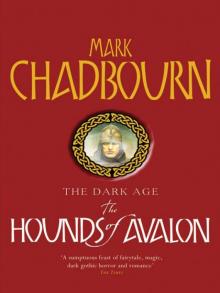 The Hounds of Avalon tda-3
The Hounds of Avalon tda-3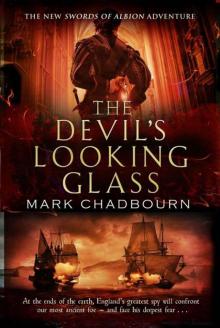 The Devil's Looking-Glass soa-3
The Devil's Looking-Glass soa-3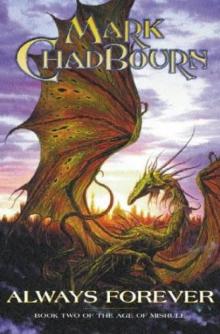 Always Forever taom-3
Always Forever taom-3 The Scar-Crow Men
The Scar-Crow Men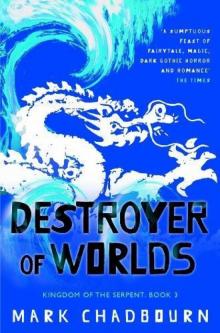 Destroyer of Worlds kots-3
Destroyer of Worlds kots-3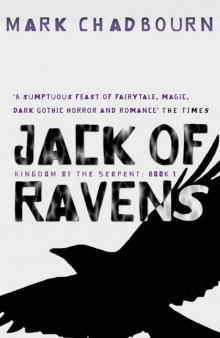 Jack of Ravens kots-1
Jack of Ravens kots-1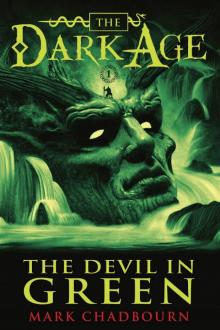 The Devil in Green
The Devil in Green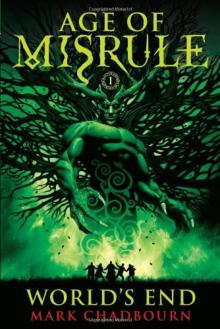 World's End
World's End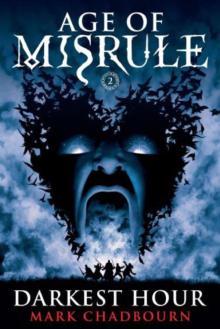 Darkest Hour (Age of Misrule, Book 2)
Darkest Hour (Age of Misrule, Book 2) Destroyer of Worlds
Destroyer of Worlds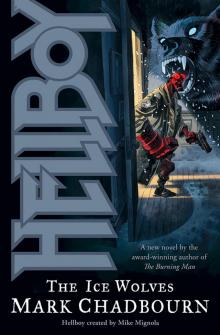 The Ice Wolves
The Ice Wolves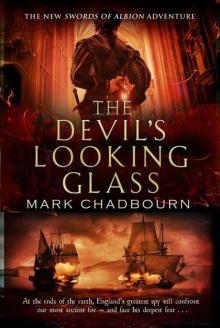 The Devil soa-3
The Devil soa-3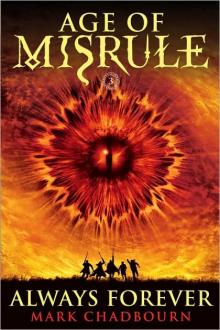 Always Forever
Always Forever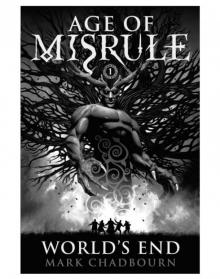 World's End (Age of Misrule, Book 1)
World's End (Age of Misrule, Book 1)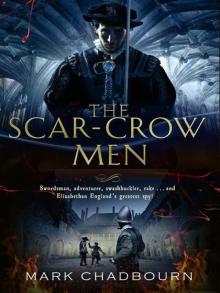 The Scar-Crow Men soa-2
The Scar-Crow Men soa-2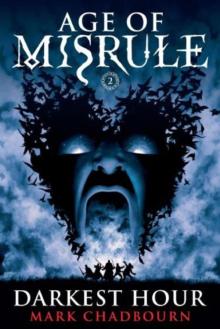 Darkest hour aom-2
Darkest hour aom-2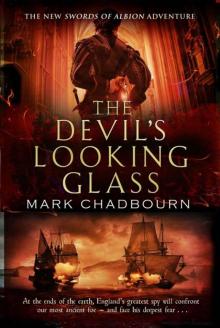 The Devil's Looking-Glass
The Devil's Looking-Glass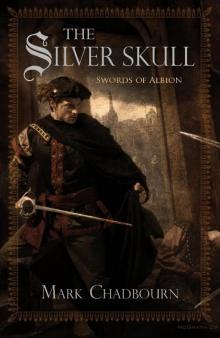 The Silver Skull
The Silver Skull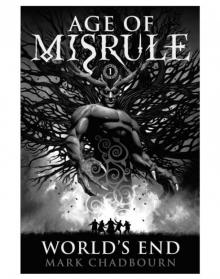 World's end taom-1
World's end taom-1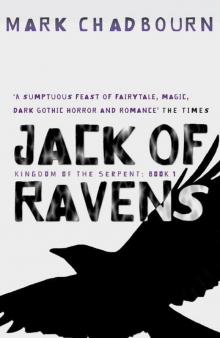 Jack of Ravens
Jack of Ravens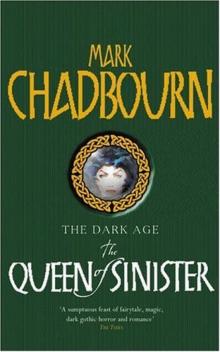 The Queen of Sinister
The Queen of Sinister